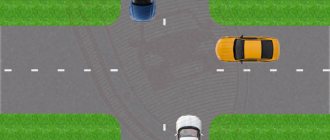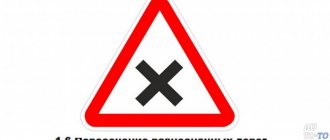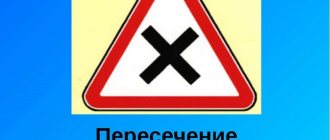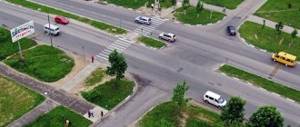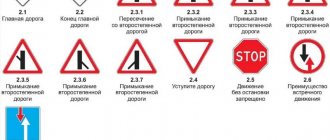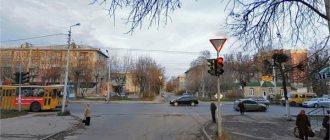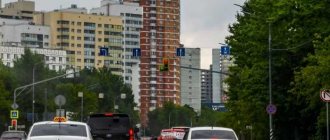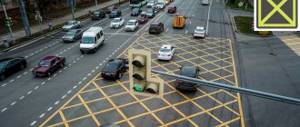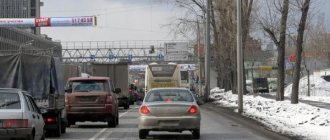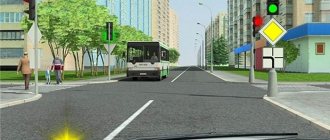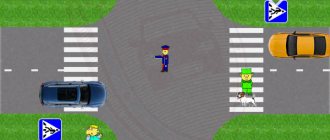Movement along the "main"
How to determine which road a car is traveling on? In this case, it is worth turning to the definition. The main road, in accordance with clause 1.2 of the traffic rules, is indicated by signs 5.1, , 2.1 in relation to the adjacent one or has a hard surface (stone material, cement and asphalt concrete, etc.). It also includes any route relative to exits from adjacent territories. In some cases, the section of the secondary road that is located in front of the intersection has a hard surface. However, this does not make it equal to the one it intersects.
Unregulated intersection of unequal roads
As was said above, when approaching the site, you should accurately determine which path the movement is taking - the secondary or the main one. Let's analyze the situation when all the signs are in place. In this case, traffic is carried out along the main road, which goes straight without changing direction, and there are no tram tracks. Let's remember the rules of uncontrolled intersections:
- Movement is carried out along the main road. This means that those vehicles driving on the secondary lane should let through. In this case, the direction of movement along the main road does not matter.
- There is no tram route, so priority for this transport does not apply.
- The rule about “interference on the right” is necessary if the passage of uncontrolled intersections is carried out with a left turn or a U-turn. However, before this, you should give way to cars moving on the “main” road straight ahead and to the right.
Turn left and U-turn
It often happens that a driver driving a car wants to turn around at the intersection of equivalent roads, or make a left turn. In order to perform the indicated maneuvers, he must know which vehicles he will have to let through, and which ones he himself has an advantage over.
According to the traffic rules, the driver must give priority to all vehicles moving along the same path as the owner of the car turning left or turning around.
In addition, cars passing the intersection in the oncoming lane also have priority in traffic. You need to pay particular attention to this requirement when turning.
It is not without reason that a left turn or a U-turn on the section of road in question is considered a maneuver that poses the greatest danger. For this reason, you should be as careful and attentive as possible when performing these maneuvers.
What is an equivalent road and an unequal one - equivalent intersection sign
The intersection is rightfully one of the most dangerous areas of automobile traffic. For both novice drivers and experienced motorists, driving through intersections is undeniably associated with the risk of becoming the culprit or victim of a traffic accident. Often, many accidents could have been avoided if all road users had adhered to the traffic rules, which established certain rules and patterns for the order of passage of intersections for all vehicles.
What kind of intersections are there?
First of all, it is necessary to determine the types of intersections, and only then determine who should yield to whom, when. Intersections are divided into equivalent and unequal. In turn, intersections, which include unequal roads, are divided into 2 types - regulated and unregulated. If, for example, there is a traffic light, the intersection is controlled. The only exception is the case with a traffic light, where only the yellow signal is constantly flashing. In this case, the order of passage must be determined by road signs, as well as by the rule of interference on the right.
How to understand an equivalent and unequal road
An intersection is considered controlled if the traffic order is determined by a traffic controller.
How to recognize if roads are of equal value.
The absence of priority signs, coupled with the same type of road surface, indicates that you are approaching an intersection of equivalent roads. For example, if two dirt roads intersect in a village, this is an intersection of equivalent roads. If dirt and asphalt roads intersect, then the asphalt road is the main one. However, it is worth clarifying that if a certain section of the exit onto a dirt road is paved, this does not make it the main or equivalent road in relation to the road being crossed, which is paved throughout its entire length. Asphalt roads are also equivalent if there are no priority signs, traffic lights, or traffic controllers.
How to drive through intersections of equivalent roads.
The simplest case is an intersection of equivalent roads. All road users must adhere to the right obstruction rule: the vehicle approaching from the right passes first. If you want to turn left, you must give way to everyone driving in oncoming traffic, as well as to those who are an obstacle on the right.
How to recognize the intersection of unequal roads.
The presence of a traffic light, a traffic controller, priority passage signs, differences in road surface (dirt and asphalt) - these are the main signs that you are facing an intersection of unequal roads. Let us immediately make a reservation that intersections formed by the transfer of unequal roads are divided into 2 types: regulated and unregulated. The adjustment is made either with the help of a traffic controller or with the help of a traffic light. To correctly understand the order of travel, we recommend studying the traffic lights and traffic controller signals.
How to drive through an intersection of unequal roads without adjustment.
Uncontrolled intersections of unequal roads are the most dangerous places. The order of passage is a little more complicated than at intersections of equivalent roads, but you can figure it out by the priority signs. For example, the presence of a “Give Way” sign indicates that you are approaching an intersection from a secondary road, and the presence of a “Main Road” or “Exit from a Main Road” sign tells us that you are approaching an intersection on a main road. Consequently, those on the main road pass first, and then those on the secondary road leave. At the same time, those approaching the intersection from the side of a secondary road are guided among themselves by exactly the same order of passage as is used in the case of passing roads of equivalent importance.
Fliegl semi-trailers are the standard of quality from the German manufacturer.
Road sign 1.6 “Intersection of equivalent roads”
An intersection is a place of increased danger for both drivers and pedestrians. After all, traffic flows moving in different directions intersect here, and it is very important to adhere to all the rules related to traffic at the intersection in order to avoid accidents.
Intersecting roads can be of equal or unequal significance. The approach of an intersection with equivalent roads is signaled to the driver by road sign 1.6 “Intersection of equivalent roads , which is a black cross, the crossbars of which are placed diagonally, depicted on a white background and enclosed in a red triangle.
This sign means that roads that intersect are of equal importance, regardless of the road surface.
The first thing a driver must do when he sees such a sign is to slow down, since it is very likely that he will have to give way to vehicles moving on the right. And even if he always drove along the road designated as the main one at previous intersections, still at the intersection in front of which there is a sign 1.6, he will have to give way to cars moving on the right.
Rail transport, for example, a tram, also has an advantage at intersections with equivalent roads. Drivers of vehicles promise to always let him through, no matter from which direction he moves.
Sometimes it happens that sign 1.6 “Intersection of equivalent roads” is not installed in front of intersections.
This can happen in rural areas or low-traffic city lanes. In such cases, it is important to be able to read the intersection and sort out priorities. In any case, it would be a good idea to let traffic moving on the right pass, and, having passed the intersection, pay attention to the sign that is installed in front of it.
At intersections marked with sign 1.6., a situation may arise when each driver has an obstacle on the right. In this case, drivers must decide their own driving order. For example, by briefly switching the high-low beam headlights.
How to understand an equivalent and unequal road
This signal means “I’m the last to go.” This means that you will not be a hindrance to other drivers.
A sign notifying the driver of the approaching intersection with equivalent roads, like other warning signs, is installed in the city at a distance of 50 - 100 meters before the intersection, outside the city - at a distance of 150 - 300 meters before the intersection. The difference in distance is explained by the fact that on country roads, drivers reach higher speeds and take longer to slow down.
Topic 13.2. Uncontrolled intersections of unequal roads
Having the skills to move a vehicle, the driver also needs to know the rules by which the safe movement of cars and other vehicles is allowed.
On the way of travel, the driver encounters an intersection. In most cases they are regulated or one of the roads is the main one. However, there are also equivalent roads that have their own characteristics when crossing an intersection.
Without knowledge of traffic rules, driving through intersections from equivalent roads can result in negative consequences.
The concept of equivalence
Such intersections require motorists to not only know who has the right of way, but also how to properly give priority to other vehicles to prevent accidents and injuries.
At first glance, giving a precise definition of this concept will not be difficult even for a car enthusiast who has been driving for only a few days.
However, simply memorizing the definition will not be enough, because the driver is also required to understand how movement occurs at the intersection of equivalent roads.
Areas that relate to the concept of intersection of equivalent roads can be classified as follows:
- adjustable,
- unregulated.
When a motorist approaches the first option for crossing roads, it will be much easier to overcome it, because his actions will be regulated either by a traffic light or
There are several simple but very important circumstances that you need to know and use when driving through a controlled intersection of equivalent roads.
This list includes the following items:
- When the traffic light is functioning without failure, vehicles pass through the intersection according to its instructions.
- When a traffic controller is responsible for regulating traffic, all vehicle drivers must obey his commands. It is worth noting that the traffic controller’s instructions are given priority even when the traffic light is running.
Responsibility for violating the rules
If we touch on the issue of punishments, then sign 1.6 refers to warning types of markings. Therefore, responsibility for non-compliance with the restrictions that it fixes on domestic roads for citizens comes in accordance with Article 12.13 of the Code of Administrative Offenses of the Russian Federation.
Typically, sanctions are applied for failure to provide the right of way and for creating obstacles for other vehicles (driving onto a roadway that is already crowded with parked cars). In situations where photo and video recording is carried out at the mentioned intersection, the irresponsible driver will be issued an administrative violation report and a fine of about 1 thousand rubles.
In addition, it is quite possible that liability will arise on the basis of other regulations and articles of the Code of Administrative Offenses if the owner of the car overtakes another vehicle at an intersection.
It provides for financial sanctions in the form of a fine of 5 thousand rubles. As an alternative, the use of related restrictive measures is allowed: the driver’s license may be temporarily suspended.
Such a restriction will be in effect from 4 months to 6 six months (Part 4 of Article 12.15).
The least problematic situation will come when the driver forgot to turn on the turn signal on the eve of a maneuver (right or left turn, U-turn, braking).
This violation already threatens with a verbal warning or a monetary penalty of 500 rubles. (according to Part 1 of Article 12.14).
Such common mistakes on the road arise due to insufficient theoretical knowledge and, in fact, are not a serious basis for releasing the driver from liability.
Signalized intersections
The first step at any intersection is to check whether it is controlled or not. Therefore, when approaching an intersection, you need to try to find the traffic controller with your eyes. It is not very common to meet a traffic controller at an intersection, but he is the most important sign of a controlled intersection.
The traffic controller makes absolutely any intersection regulated, even any intersection of field or forest roads.
Only if you were unable to find a traffic controller should you pay attention to the traffic lights. There are usually no problems with finding them, because... The traffic light can be seen from afar.
If there is a traffic light at an intersection, this does not mean that the intersection is controlled. First you need to understand the operating mode of the traffic light. If the traffic light is operating in normal mode (red-yellow-green), then the intersection is adjustable and you can breathe easy.
If the traffic light is in flashing yellow mode or is turned off, then the intersection is uncontrolled and you will have to put in a little more effort to figure out its type.
Key Aspects
Equivalent intersections are divided into two types - regulated and unregulated. If the car owner needs to drive through the first type of road intersection, he will simplify his task.
In this case, the person will receive instructions that will allow him to understand how to act in the current situation.
A traffic controller or a traffic light can control traffic at an equivalent intersection. It should be remembered that such sections of the road are not regulated by signs.
Otherwise, the intersection ceases to be of equal importance, because priorities are set. There are a number of rules that must be followed at the intersection of equivalent roads.
The list includes the following statements:
| If the traffic light is operating in standard mode | The movement of vehicles must be carried out in accordance with its instructions |
| If traffic on a section of the road is controlled by a traffic controller | Drivers are required to follow his instructions. Moreover, its commands have higher priority than traffic light signals. The point is that sometimes you need to adjust the movement manually. The traffic light, in the presence of a traffic controller, fades into the background |
| If crossing a section of the highway is carried out under a red light and there is a green sign | It is necessary to give way to cars whose trajectory coincides with the path of the driver’s vehicle. |
Experts advise periodically refreshing your memory of traffic rules. This will allow the driver to know exactly what to do in the current situation.
In addition, if the vehicle owner follows traffic rules, the likelihood of accidents will be minimized.
What it is
An intersection is an intersection of roads at the same level. In city conditions, such a phenomenon happens quite often, but on the highway the need to overcome road intersections is less common.
Once near an intersection, the driver must determine its type. It depends on how this or that type of transport will behave when it is about to drive straight or make a U-turn.
Typically, an equivalent intersection is not regulated by any of the known methods.
In addition, for the intersection of highways to be considered equivalent, all roads that intersect must have the same surface.
Not all drivers know that the material of which the road is made determines whether there is an advantage.
So, if a driver is going to drive from a dirt road onto an asphalt road, he is obliged to let cars moving along it pass.
It is believed that asphalt has a greater advantage than a road made of other materials.
There are a number of other features, the presence of which may lead to the intersection being considered unregulated. These include:
- The presence of a non-working traffic light.
- The traffic light is flashing yellow without switching to others.
- The regulator does not carry out the duties that were assigned to him.
In most cases, missing pointers cause problems. Drivers do not understand how to behave in the current situation, and act as they see fit.
However, the lack of a clear system leads to traffic jams and congestion.
To avoid their occurrence, it is necessary to follow the rules that apply when the driver crosses equal and unequal roads.
Rules for driving at uncontrolled intersections of equal roads
When driving through an intersection of equivalent roads, we are guided by the “interference on the right” rule.
- When turning right, we do not need to give way to anyone.
- Passing the intersection in the straight direction, we give way to the right (to the black car). In the case when black, green and blue cars are also driving straight, the drivers will have to decide for themselves who will go first, because the rules do not regulate this situation.
- When turning left, both black and green cars will be an obstacle for us on the right.
- When performing a turn, you will have to yield to all three directions.
Travel rules
How to follow through the intersection of paths is described in paragraph 13 of the traffic rules. Among the requirements there are general ones that must be fulfilled regardless of its status. But an equivalent intersection dictates special rules of passage that differ from those existing for the convergence of the main and secondary roads.
Who gives in
The main thing that interests drivers is the ability to quickly leave a difficult area. If this is an equivalent intersection, who gives way should be looked at in subparagraph:
At an intersection of equivalent roads, except in the case provided for in paragraph (1) of the Rules, the driver of a trackless vehicle is obliged to give way to vehicles approaching from the right. Tram drivers should follow the same rule among themselves.
On this section, the tram has an advantage over cars, buses, and motorcycles. It should be allowed through regardless of which direction the rail transport is approaching from.
The need to give way to pedestrians and cyclists crossing the roadway into which a car is turning does not go away. It is established by subclause 13.1.
If there is a traffic light on the site, the priority of passage is determined by its signals. According to the traffic rules, an equivalent intersection makes the following rules mandatory:
- when turning left on a green light, you need to give way to those who are driving towards you and are going to go straight or to the right;
- cars turning when green lights in the additional section of the traffic light and red (yellow) in the main one are on at the same time allow those moving from other directions to pass;
- It is necessary to yield to vehicles and pedestrians completing their passage through the roadway.
U-turn
How to make a U-turn at an equivalent intersection is stated in the subparagraph of the traffic rules. It is necessary to give way to those who are driving straight in the oncoming lane or are about to turn right. The same requirement exists when there is a traffic light operating in the area. You can only turn around when the signal is green. And in both cases, there should be no symbols prohibiting maneuver on the site.
Overtaking
To understand whether overtaking is allowed at an equivalent intersection, you need to look at subclause 11.4 of the traffic rules. The maneuver is prohibited in this area if:
- traffic is regulated by a traffic light or police officer;
- The car is not driving on the main road.
The intersection of paths with the same status meets either both of these conditions or only one of them. This means that the maneuver is prohibited regardless of whether there is a traffic light on the site or not.
In both cases, only advance is allowed. That is, in order to overtake a slower car, you can move in the same direction, but not in the oncoming lane.
How not to get confused on the road if you encounter an equivalent intersection
There are quite a lot of intersections of equivalent roads outside the city, where it is customary to use high speed.
Therefore, it is important to know how to drive through this section, who should give way, as well as the peculiarities of performing maneuvers on it. Otherwise, violation of the rules will lead to an accident, the consequences of which are difficult to predict.
Read the article about the difference between an equivalent intersection and how to overtake and turn around at it.
How to determine the intersection of equivalent roads: signs and features
The driver must have a good understanding of how to determine an equivalent intersection in order to be ready to cross it strictly according to the rules even at the entrance. And they differ from the conditions of traveling through the convergence of the main and secondary roads. How to understand that intersecting directions have equal meaning:
- they have the same surface (asphalt, soil, etc.);
- there are no priority symbols (2.1, 2.4, 2.3.1-2.3.7);
- 50-100 m before it (in the city) and 150-300 m (outside the populated area) there is a sign “Crossroads of equivalent roads” (1.6), directly indicating that at this point paths with the same status converge.
Symbol 1.6 is an equilateral triangle with a white main background and a red border. It shows a cross in black, similar to the letter X.
Sometimes there are no signs on the site, and the surface of the road is hidden by snow or dirt. Drivers should then consider it to be the convergence of the main and secondary tracks. This is required by subclause 13.13. Rules
The intersection of equivalent roads can be controlled. That is, the order of movement on it is determined by the signals of a traffic light or a policeman with a baton. The travel features here are clear. But the site may also be unregulated. And in order to proceed through it, you must adhere to certain traffic rules. And they differ from what is required in the regulated area.
Equal and unequal in traffic rules
Equivalent and unequal intersections are separated in the “Rules...”, although the document does not contain explanations of both terms. But there is the concept of “main road”:
road" - a road marked with signs 2.1, 2.3.1 - 2.3.7 or 5.
1, in relation to the one being crossed (adjacent), or a road with a hard surface (asphalt and cement concrete, stone materials, etc.) in relation to a dirt road, or any road in relation to exits from adjacent territories. The presence of a paved section on a minor road immediately before the intersection does not make it equal in importance to the one it intersects.
If there is one, the direction that crosses it is secondary. And the intersection is unequal. The absence of such a division of converging paths changes its status to the opposite.
Among the main terms used in traffic rules, there is also the following:
Give way (do not interfere)" is a requirement that means that a road user must not start, resume or continue moving, or carry out any maneuver if this may force other road users who have priority over him to change the direction of movement. or speed.
It relates both to unequal intersections of paths and to those where roads with the same status converge. But the requirement in both cases is fulfilled according to different rules.
In the very definition of an intersection there is no explanation of what they are. But this does not negate the differences.
Travel rules
How to follow through the intersection of paths is described in paragraph 13 of the traffic rules. Among the requirements there are general ones that must be fulfilled regardless of its status. But an equivalent intersection dictates special rules of passage that differ from those existing for the convergence of the main and secondary roads.
Who gives in
The main thing that interests drivers is the ability to quickly leave a difficult area. If this is an equivalent intersection, who gives way should be looked at in subclause 13.11:
At an intersection of equivalent roads, except in the case provided for in paragraph 13.11(1) of the Rules, the driver of a trackless vehicle is obliged to give way to vehicles approaching from the right. Tram drivers should follow the same rule among themselves.
On this section, the tram has an advantage over cars, buses, and motorcycles. It should be allowed through regardless of which direction the rail transport is approaching from.
The need to give way to pedestrians and cyclists crossing the roadway into which a car is turning does not go away. It is established by subclause 13.1.
If there is a traffic light on the site, the priority of passage is determined by its signals. According to the traffic rules, an equivalent intersection makes the following rules mandatory:
- when turning left on a green light, you need to give way to those who are driving towards you and are going to go straight or to the right;
- cars turning when green lights in the additional section of the traffic light and red (yellow) in the main one are on at the same time allow those moving from other directions to pass;
- It is necessary to yield to vehicles and pedestrians completing their passage through the roadway.
U-turn
How to make a U-turn at an equivalent intersection is stated in subclause 13.12 of the traffic rules. It is necessary to give way to those who are driving straight in the oncoming lane or are about to turn right. The same requirement exists when there is a traffic light operating in the area. You can only turn around when the signal is green. And in both cases, there should be no symbols prohibiting maneuver on the site.
Overtaking
To understand whether overtaking is allowed at an equivalent intersection, you need to look at subclause 11.4 of the traffic rules. The maneuver is prohibited in this area if:
- traffic is regulated by a traffic light or police officer;
- The car is not driving on the main road.
The intersection of paths with the same status meets either both of these conditions or only one of them. This means that the maneuver is prohibited regardless of whether there is a traffic light on the site or not.
In both cases, only advance is allowed. That is, in order to overtake a slower car, you can move in the same direction, but not in the oncoming lane.
If equivalent unregulated
An unregulated intersection is one of the most difficult sections on the road. But problems can be avoided by adhering to the following rules:
- when passing, give way to vehicles approaching from the right side and trams;
- when turning left, you must give way to vehicles driving in their lane towards you without changing the trajectory or to the right;
- turning around, fulfill the same condition;
- Do not overtake in the area.
Example of an accident at an intersection of equivalent roads
An equivalent intersection makes the following situations likely that could lead to an accident:
- Car A is about to turn left. Car B is moving along a road perpendicular to its original direction. It does not turn anywhere. And her driver is sure that he has priority, so a collision occurs. In fact, driver B was obliged to yield, since car A was approaching him from the right. And despite the fact that A was turning left, he should not have yielded to his opponent. After all, B was driving not from the opposite direction, but from the side.
- Four cars are simultaneously approaching the intersection of paths with the same status from all sides. Among them there is someone who wants to turn left, turn around and go straight. In this case, each of the four cars must yield to one of the opponents. This means that no one will move first, because this will become a traffic violation.
If the rules are not followed, all vehicles can be involved in such an accident. It can be avoided if each driver slows down before the section and assesses the situation. And then, with the help of gestures, they should agree on who will pass first.
We recommend that you read about the rules for driving at a T-junction. From the article you will learn about the rules of travel at regulated/unregulated, equivalent, T-shaped intersections with traffic lights.
And here is more information about the reasons that most often lead to accidents at intersections.
Intersections of equivalent roads are quite problematic areas, despite the fact that travel is regulated by several rules. But in a real situation, it is sometimes difficult to apply them right away. To have time for this, you need to approach the intersection at an adequate speed. And also know the traffic rules and respect other road users.
Watch this video about the rules for driving at an unregulated intersection of equivalent roads:
Source: https://avto-urist.online/ravnoznachnyj-perekrestok/
Main difficulties
Priority passage at uncontrolled intersections can thus be determined by the presence of the signs listed above, establishing where the “main” is, as well as by signs 2.4, requiring you to give way, and 2.5, prohibiting passage without stopping. The latter indicate a secondary area.
However, today there are often intersections where these signs are missing for some reason or are hidden (for example, by tree foliage). The driver, however, in any case needs to know which path he is moving on - the secondary or the main one. In this regard, when approaching an uncontrolled intersection, when a motorist is looking for a traffic light with his eyes, he should also look for identification signs. The latter can be detected much faster, especially in sunny weather, since in bright sunshine warning signals are not always recognized in time.
What could be an insoluble situation at a crossroads?
The intersection of equivalent roads can often involve situations the exit from which will not comply with traffic rules.
Such a case can occur when cars arrive at the same time and at the same time on each of the 4 sides there is at least one that is going to go straight or make a U-turn. The intractability of the situation lies in the fact that each driver is obliged to give way to another car located on his right side, because of this, everyone else remains at the intersection and is not able to pass.
But the following way out can be found - all transport that comes from one direction can turn right, and other cars will move away over time. But still, if this situation arises, then if you are not in a hurry, then the best advice would be not to make the first turn to the right, but to wait, so as not to risk it again.
This is so because you yourself, having approached the intersection, have already taken a certain position from which you are going to exit, and if you start turning right, this can often be like a violation of the rules. It also often happens that when you turn right, you end up in an unknown place where you can’t even turn around normally, so the best option would be to take your time, no matter what the load, and then drive through it calmly.
Example of an accident at an intersection of equivalent roads
An equivalent intersection makes the following situations likely that could lead to an accident:
- Car A is about to turn left. Car B is moving along a road perpendicular to its original direction. It does not turn anywhere. And her driver is sure that he has priority, so a collision occurs. In fact, driver B was obliged to yield, since car A was approaching him from the right. And despite the fact that A was turning left, he should not have yielded to his opponent. After all, B was driving not from the opposite direction, but from the side.
- Four cars are simultaneously approaching the intersection of paths with the same status from all sides. Among them there is someone who wants to turn left, turn around and go straight. In this case, each of the four cars must yield to one of the opponents. This means that no one will move first, because this will become a traffic violation.
If the rules are not followed, all vehicles can be involved in such an accident. It can be avoided if each driver slows down before the section and assesses the situation. And then, with the help of gestures, they should agree on who will pass first.
And here is more information about the reasons that most often lead to accidents at intersections.
Intersections of equivalent roads are quite problematic areas, despite the fact that travel is regulated by several rules. But in a real situation, it is sometimes difficult to apply them right away. To have time for this, you need to approach the intersection at an adequate speed. And also know the traffic rules and respect other road users.
What is a T-junction?
A T-junction is an intersection that appears to be the intersection of two roads, but one road appears to flow into the other and is most often a perpendicular line between the two lines. In drawings it is usually depicted as two lines with a right angle.
Interestingly, a T-junction, although slightly different from a regular road crossing, has the same clearance requirements.
This type of intersection can also be multi-valued and unequal. It is usually easier for drivers to overcome it due to the fact that there are only three directions of movement here.
There are rules for driving through an uncontrolled T-junction. However, they are no different from other intersections. If it is equal, then the driver must give way to a vehicle passing on the right, and if not, he must follow the rules defining the main and secondary roads.
If a T-junction turns into a road, then you can only turn around or turn left (if driving on the right).
What is an equivalent road
Such transport routes, as a rule, have low-quality asphalt pavement. Near them there is also often no regulatory device: a sign, a traffic light, a speed bump. Similar roads are found in rural areas. Only there the asphalt is replaced by a dirt surface. The question arises, how to qualify and pass such roads?
Similar roads are considered equal. Legislation deciphers the meaning of the concept in its own way. According to the current traffic rules, an equivalent (equal) road is:
- part of a transport route;
- lack of traffic lights, traffic controller;
- has an asphalt or dirt surface;
- there is no permit sign on it.
In themselves, such paths do not pose any difficulties for experienced drivers, but beginners do not feel so confident when driving through such sections of road surfaces. Difficulties often arise when driving through crossroads on equal roads, because another vehicle may unexpectedly appear around the bend. Attentiveness plus strict adherence to the rules help avoid conflict situations.
The concept of an intersection of equivalent roads
The intersection of two equal paths is a fairly common phenomenon in a city or village. This phenomenon is called “crossroads of equivalent roads.” For designation use the sign number 1.6. It is a triangle with a red frame. Inside there is an intersection of black straight lines.
Crossroads outside large populated areas, as a rule, are not equipped with signs.
Two types of intersection can be found. The most common method is a crossroads, when two roads are placed perpendicular to one another. Less common, but no less important, is a T-junction, when 3 roads come together and there is no direct traffic. Travel standards for both types of roads are the same. The main thing is to follow the rule of the right side. Its essence is as follows: wherever the driver goes, he must pass vehicles located to his right, that is, an obstacle to the right.
Uncontrolled intersection: what is it?
The traffic rules clearly state what the rules of passage and definition are. In general, any intersection is an intersection of roads in one plane, and the word “unregulated” means that there is neither a traffic light nor a traffic controller.
Many novice drivers think that driving through an uncontrolled intersection couldn’t be easier, but statistics say completely the opposite. It was during such maneuvers that the largest percentage of collisions was recorded. But everything is very simple: one did not want to let the other pass or overestimated his strength, and the second followed the principle or simply did not notice the obstacle.
It is also interesting that an intersection is not necessarily a four-way intersection of roads. Intersections can also be T-shaped, in the form of a triangle, circle or star.
Driving school online
How do we understand this – an equivalent road at the crossroads of unequal roads?! The rules mean the following: both you and the tram are on the main road. Or both, you and the tram - on a secondary road. In this case, the tram moves either in the opposite direction or in the same direction.
What is characteristic of the intersection of unequal roads? Firstly, this is necessarily an unregulated intersection. There are no traffic controllers or traffic lights here. Or there are traffic lights, but they do not work or are switched to flashing yellow mode. And, secondly, one road is the main one, and the others (no matter how many there are) are secondary.
12 Jul 2021 1455
As the traffic rules state, today there are several ways to regulate intersections, these are:
- Traffic light;
- Traffic signs;
- A traffic police and traffic police officer, that is, a traffic controller;
In addition to regulating intersections with the intervention of third parties or special equipment (signs or traffic lights), there are additional rules that, in the absence of all components, can resolve the dispute.
Today it is:
- Uneven road surfaces. The surface of the road determines the role of traffic at the intersection along it. That is, if the intersection is the intersection of a gravel and asphalt surface. The road with an asphalt surface is considered the main one.
- Right hand rule. If the traffic of the intersection is not regulated in any way and the road surface is equal, then we are guided by the “obstacle on the right.” That is, all those vehicles that are on the right have a primary role, which means that the driver on the left gives way.
According to the traffic rules, an intersection where the traffic order is not regulated by traffic lights, traffic police officers, that is, a traffic controller, signs, as well as an intersection where the roads have the same surface, is an unregulated intersection of equivalent roads.
From here we get that an equivalent road is a section of the road that is not regulated, either by signs or devices, where there is no traffic controller. At the same time, the road coverage is equal. A crossroads of equivalent roads is an intersection of streets where the directions are equal in meaning.
Then, as the traffic rules say, the driver must follow the right-hand rule. That is, let everyone who is on the right side of the intersection pass. In turn, the driver who moves along the intersection on the right side has the main road and should not allow vehicles on his left to pass.
The concept of equivalence
Such intersections require motorists to not only know who has the right of way, but also how to properly give priority to other vehicles to prevent accidents and injuries.
At first glance, giving a precise definition of this concept will not be difficult even for a car enthusiast who has been driving for only a few days. However, simply memorizing the definition will not be enough, because the driver is also required to understand how movement occurs at the intersection of equivalent roads.
When the person behind the wheel lacks practical skills, this can lead to an increased risk of road accidents or even cause an accident.
Areas that relate to the concept of intersection of equivalent roads can be classified as follows:
- adjustable,
- unregulated.
When a motorist approaches the first option for crossing roads, it will be much easier to overcome it, because his actions will be regulated either by a traffic light or by traffic controllers.
There are several simple but very important circumstances that you need to know and use when driving through a controlled intersection of equivalent roads.
This list includes the following items:
- When the traffic light is functioning without failure, vehicles pass through the intersection according to its instructions.
- When a traffic controller is responsible for regulating traffic, all vehicle drivers must obey his commands. It is worth noting that the traffic controller’s instructions are given priority even when the traffic light is running.
It is important to remember that there are no road signs at the intersection of equivalent roads, because they set priorities for passing such sections. In other words, the intersection will become unequal.
How to identify a main road without signs
Arthur, one is the main one, the other is secondary. . these are unequal) it can be an asphalt road in relation to a dirt road, or a road with a “main road” sign in relation to a road with a “give way” sign. equivalent - these are roads at the intersection of which the order of travel is determined either by the traffic controller or by the drivers themselves according to the rule “interference on the right”
Gennady 1. Equal roads - roads with the same surface Valery without priority signs Evgeny. 2. Unequal roads - with different surfaces Denis will always be the main one in relation to the dirt road). Unequal roads are also identified by priority signs: “Give way” means the road is of secondary importance. “Main road” is the main road, you have priority.
How to determine the intersection of equivalent roads: signs and features
The driver must have a good understanding of how to determine an equivalent intersection in order to be ready to cross it strictly according to the rules even at the entrance. And they differ from the conditions of traveling through the convergence of the main and secondary roads. How to understand that intersecting directions have equal meaning:
- they have the same surface (asphalt, soil, etc.);
- there are no priority symbols (2.1, 2.4, 2.3.1-2.3.7);
- 50-100 m before it (in the city) and 150-300 m (outside the populated area) there is a sign “Crossroads of equivalent roads” (1.6), directly indicating that at this point paths with the same status converge.
Symbol 1.6 is an equilateral triangle with a white main background and a red border. It shows a cross in black, similar to the letter X.
The intersection of equivalent roads can be controlled. That is, the order of movement on it is determined by the signals of a traffic light or a policeman with a baton. The travel features here are clear. But the site may also be unregulated. And in order to proceed through it, you must adhere to certain traffic rules. And they differ from what is required in the regulated area.
Equal and unequal in traffic rules
Equivalent and unequal intersections are separated in the “Rules...”, although the document does not contain explanations of both terms. But there is the concept of “main road”:
Main road" - a road marked with signs 2.1, - or 5.1, in relation to the one being crossed (adjacent), or a road with a hard surface (asphalt and cement concrete, stone materials, etc.) in relation to a dirt road, or any road in relation to travel from surrounding areas. The presence of a paved section on a minor road immediately before the intersection does not make it equal in importance to the one it intersects.
If there is one, the direction that crosses it is secondary. And the intersection is unequal. The absence of such a division of converging paths changes its status to the opposite.
Among the main terms used in traffic rules, there is also the following:
Give way (do not interfere)" is a requirement that means that a road user must not start, resume or continue moving, or carry out any maneuver if this may force other road users who have priority over him to change the direction of movement. or speed.
It relates both to unequal intersections of paths and to those where roads with the same status converge. But the requirement in both cases is fulfilled according to different rules.
In the very definition of an intersection there is no explanation of what they are. But this does not negate the differences.
Rules for driving through an uncontrolled equivalent intersection
Driving through such an intersection must be done with caution, given that you can always meet a driver who has forgotten the rules or is confident that he is moving on the main road. When approaching an intersection of equivalent roads, remember that one rule common to all applies here: if you have an equal right to cross the intersection first, you must be guided by the “interference on the right” method .
The exception to this rule is the tram, which has an absolute advantage over all road users.
There may be no sign before the intersection at all. This is rare, but all situations need to be considered. If the driver easily notices that there are no signs, traffic lights and traffic controllers, then it is not always possible to determine the road surface for the following reasons:
- if it rains;
- if snow cover covers the road;
- if there is fog outside the window;
- in the case when the driver does not understand the coatings.
What to do in these situations? When faced with such a problem, it is best to act as if you are on a secondary road, as this is the safest option.
Right turn
When turning right, you must act according to these rules:
- upon approaching an equivalent intersection, the driver must change lanes to the rightmost lane;
- pedestrians, cyclists on the bike path, and buses will have to give way;
- the vehicle’s trajectory must adhere to the extreme right side and essentially not interfere with other vehicles’ maneuvers.
Turn left and U-turn
When performing such a maneuver, you must give way:
- to all cars that are moving on the right along trajectories that coincide with yours;
- to all the cars that are moving towards you.
The last rule is typical for a reversal. Remember that this maneuver is the most dangerous and you need to be extremely careful.
Go straight
Such a maneuver will lead to the intersection of the paths of other vehicles at the intersection, so you need to be more careful when driving straight. You need to give way:
- cars making a right turn in the same direction, if the trajectories coincide;
- vehicles moving on the right to make a U-turn or turn left;
- the transport on the right follows straight ahead.
If you meet pedestrians on the way, give them the right of way as well. To avoid accidents, do not exceed speed and act with extreme caution. In all of the above cases, you cannot go to the intersection if there is a traffic jam at it. It is important to wait until the transport leaves.
Even if the uncontrolled intersection has a roundabout, you must follow the same rules about obstacles on the right . Please note that rail transport has priority when moving in all directions. Today it often disappears from cities, and these rules are quickly forgotten by citizens.
Regulated equivalent intersection
The concept of “regulated” indirectly indicates that the traffic order rules at this intersection are determined in two ways:
- through a traffic light;
- through the regulator.
It cannot be regulated by signs, because otherwise the roads will no longer be considered equal and priorities will be set. There are a number of important rules regarding movement at these intersections:
- If the regulating device, the traffic light, is working properly, all drivers must follow the basic rules. This applies to all intersections.
- If there is a traffic controller at the intersection, drivers are required to follow his commands. The fact is that sometimes it is necessary to adjust the movement manually even when the traffic light is working. In these cases, the traffic controller will be in charge of the road.
- If you are driving at a red traffic light with an additional green arrow, you need to give way to all cars that are on the same path as yours.
It is sometimes useful to re-read the traffic rules; sometimes it helps a lot in difficult situations. Driving through an uncontrolled intersection of equal roads is one such case. In any case, always be careful and extremely polite.
Who is more important
When approaching an intersection, whether it is signalized or not, pay attention to the signs. The performance of a traffic light can only be assessed from afar if it is blinking yellow, but you may notice a traffic light that is completely turned off already too late. You must know which road you are on at any time as you approach a traffic intersection. If , then you must act on its signaling. Please note that when the traffic light is running, other priority distribution rules do not apply!
But let’s assume that there is no traffic light at the intersection, and there is no traffic controller. Then pay attention to the signs and markings. If there is a “Main Road” diamond in the direction of your movement, then you can continue moving further, naturally, giving way to a passing or oncoming tram if they need to turn. This sign gives you priority, and drivers crossing your road with a secondary road will stop and let you pass. If there is another sign in the direction of your movement, for example, “Give way” or “Driving without stopping is prohibited,” then you must stop and let cars driving along the priority road pass. Driving through an uncontrolled intersection, according to the rules that apply to a secondary road, should be carried out only when there are no obstacles for maneuver. You may have to stand for a long time, but this is primarily for safety reasons. The fact is that drivers driving on the main road will not slow down. That is, if a collision occurs, it will be quite strong and can lead to irreparable consequences.
If there is a traffic light at the intersection, then other priority signs do not work
Signs can be located either on the side or on top. Therefore, be very careful when approaching an unfamiliar section of road that is crossed by another road. If there are no symbols and designations on your side, look at the oncoming lane. Based on the shape of the sign hanging there, you can deduce what exactly it means. That is, “Main Road” is a diamond, and “Give Way” is an inverted triangle. You can navigate in the same way if the signs on your side of the road are not duplicated, but only on the opposite side.
Don't forget about which road you are driving on. If it is a dirt road joining or intersecting an asphalt road, then it is considered secondary by default. Be especially careful when driving through an uncontrolled intersection on the highway, because car speeds there are not nearly the same as in city limits, and the consequences can be disastrous. If both roads are, for example, dirt roads, then remember the rule of interference on the right.
Your actions at such a road junction should be predictable and easy to read. Other drivers must understand what exactly you will do now, so do not forget about turn signals and other signals. Make sure you are visible on the road and use your side lights. In general, you should always remember that crossing the road is a dangerous place for maneuvers. Therefore, try to strictly and strictly follow the rules when driving through an uncontrolled intersection. The rules state that movement through the traffic intersection and maneuvers on it must be carried out, in simple terms, without delays and transparently.
